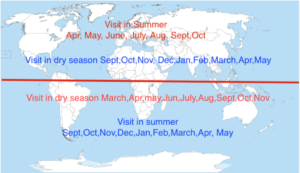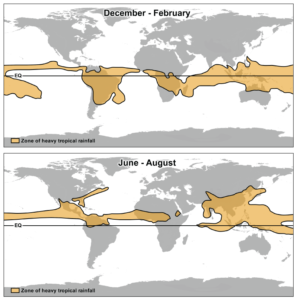w
January, Wildebeest gather on the plains of the southern Serengeti in Tanzania to calve during the latter part of the month and stay until mid-April.
The whale-watching season begins in Mexico, in Baja California and runs until the end of April. You may see fin, minke, Bryde’s, orca, pilot and humpback whales, as well as blue whale.
The dry season in Costa Rica has huge concentrations of Herons, ducks, spoonbills and other water birds around the Nicoya Peninsula.
February, Leatherback and loggerhead turtles come ashore to lay their eggs on the beaches of KwaZulu Natal in South Africa and the beaches of Western Australia.
As leaves fall, grasses wither and water sources recede in the tiger reserves of India, opportunities to see the magnificent tiger (and other game) are at their best from now until the end of April.
Orcas start arriving off the Valdes Peninsula, Argentina and can be seen until the end of April.
The months of February and March are the best for sighting minke and orca whales in Antarctica.
Penguin chicks fledge and adults moult in Antarctica. At the same time, a great chance to see fur and elephant seals who are also also moulting.
March,Botswana’s Kalahari Desert abounds with game and migrant birds following the rains.
An excellent time to go trekking in the beautiful region of Southern Patagonia in Argentina.
The Luangwa River is getting to its peak in Zambia, wildlife and birdlife is abundant.
April, April until the end of May is the best time to visit Zambia’s Bangweulu Swamps for the elusive shoebill, black lechwe and innumerable waterbirds.
April marks the beginning of the wild dog season in Zambia’s South Luangwa National Park.
A great time to see lemurs during their period of courtship in Madagascar.
Waved albatross arrive en-masse in Espanola, Galapagos, for the start of their courtship. Take a look at our Galapagos Wildlife Calendar for more information.
May, Brown bears congregate for the first time in the year in Canada, north of Vancouver to feed on succulents and to fish for salmon.
This is now the peak time for seeing grey whales in Canada off Vancouver Island’s west coast as they head north to their summer feeding grounds.
Bear watching begins in Finland and continues through to August.
Indris and sifakas produce their young in Madagascar.
During May/June Zambia’s Victoria Falls is at its fullest flow and creates quite a roar!
June, Whale sharks arrive in Shark bay Australia. June marks the beginning of dry season in subsaharan Africa good for a safari holiday.
European brown bears emerge from hibernation in Finland’s eastern wilderness.
The start of the dry season in the Pantanal in Brazil, makes this a good time to see mammals such as anteaters, crab-eating fox and howler monkeys.
This is a good time to visit the Okavanga Delta in Botswana when it’s not too hot but the wildlife viewing is great.
A good time to visit Zambia when the river levels have subsided and the air is still fresh and clear.
Migration is excellent in the Mara in Kenya during this time.
July, Basking sharks in Coll and Tiree.The islet-dotted waters of Canada’s west coast is perhaps the best place in the world to see orca whales. They will be here until early September.
The white-bearded wildebeest cross the Grumeti River and reach their dry season refuge in the Masai Mara in Kenya and stay until mid- September.
From now until mid-September you will find green, leatherback and hawksbill turtles in Costa Rica’sTortuguero National Park.
July is the best time for whale watching off the north east coast of Madagascar.
August, Humpback whales head south on their epic migration to Antarctic waters.
From now until mid-September you will find green, leatherback and hawksbill turtles in Costa Rica’s Tortuguero National Park.
Brown bears congregate for the second time in the year, north of Vancouver in Canada, to fish for salmon.
Eastern Canada’s Bay of Fundy is home to northern right, minke, humpback and fin whales between now and the end of September.
Olive ridley turtles nest at Ostional Park in Costa Rica’s Nicoya Pensinsula.
Giant tortoises return to the highlands of Santa Cruz, Galapagos.
Trek the hillsides to see gorillas in Uganda and Rwanda.
September, Many migrant birds begin to appear in southern Africa.
Late September sees thousands of colourful iridescent carmine bee-eaters re-establishing their colonies in the banks of the main river courses in southern Africa, particularly the Luangwa and Zambezi Rivers.
This month sees the arrival of fall in Canada and USA, a time of wonderful colours and scenic photographic opportunities.
The bird life becomes more vocal in the breeding season between now and the end of November in Madagascar.
Galapagos penguins are at their most active on Bartolome Island. Visit our Galapagos Wildlife Calendar to see the other wildlife visiting these islands at this time of year.
Although it’s beginning to get very warm in Namibia, because of the dry conditions the wildlife congregates around the water holes.
October, Polar bears gather in Churchill on the west coast of Hudson Bay in Canada.
The last dry month in southern Africa and the best time to see large concentrations of wildebeest, buffalo and zebra as they congregate near the main water courses and rapidly drying lagoons.
India’s national parks open at the end of the monsoon season.
The Galapagos fur seals begin mating. Go to our Galapagos Wildlife Calendar to find out more.
October/November is the height of the courting season for penguins and seabirds in Antarctica.
Spring wildflowers are at their best in the Falklands and South Georgia.
It’s becoming dryer in the Pantanal in Brazil so great opportunities to see jaguar, maned wolf and giant anteaters.
November, The Indian ‘dry’ season begins now and national parks and wildlife reserves re-open after the monsoon.
The beginning of the Austral Summer and the only time to visit Antarctica and the Falklands. Between now and March the area is superb for whales, seabirds, seals and numerous penguins.
Olive ridley, and leatherback turtles may be seen between now and April in Costa Rica’s Tamarindo Bay.
Leatherback turtles come ashore to nest on beaches until the end of March.
Wildebeest cross back down the eastern corridor of the Serengeti in Tanzania when the rains are approaching.
This is the beginning of the green season in the Luangwa Valley in Zambia with great birdwatching from now until May.
An excellent time to visit Nepal after the monsoon rains and the air is clear.
December, A huge population of green turtles gathers off the shores of the Galapagos Islands to mate, socialise and then lay their eggs.
Humpback and sperm whales can be seen now and in January along the coastline of the Corcovado National Park in Costa Rica.
The first young waved albatross fledge in the Galapagos.
In December/January it is mid summer in Antarctica bringing the warmest months and longest days. At this time of year, penguin chicks hatch and whale sightings increase.
Monsoons
Asia, India, and Australia
With the world’s strongest monsoons, this region stretches from the South China Sea into the Indian Ocean and includes Asia and the northern end of Australia. From June until September, summer monsoon rains occur in South Asian countries such as Vietnam, Thailand, Cambodia, Bangladesh, Laos, India, and Pakistan.
From December until February, the monsoon rains move south of the equator towards Australia while South Asia experiences dry monsoon conditions. There is even an East Asian monsoon that brings summer rain to China, Japan, and Korea, but it is caused by a different type of wind pattern associated with the jet stream.
The Americas
From June to August, which are summer months in the Northern Hemisphere, there is more rainfall north of the equator in Costa Rica, Nicaragua, Panama, and western Mexico. From December to February there is more rainfall south of the equator in Brazil. The North American monsoon does bring moisture from the warm waters of the Pacific into the U.S. Southwest, but its peak rainfall occurs in Mexico, and the U.S. states of Arizona and New Mexico lie in its periphery. These areas are typically dry but can receive enough rainfall to quell a wildfire if moist monsoon winds blow in summer. An area of summer rainfall along the U.S. East Coast is associated with what some might call a mid-latitude version of monsoon rainfall.
Africa
During Northern Hemisphere summer, the Intertropical Convergence Zone (ITCZ) over Africa lies far north of the equator, just south of the Sahara Desert in an area known as Sub-Saharan Africa. Moist winds blow from the Atlantic and produce rain once they reach West Africa in countries such as Mali, Niger, Ghana, and the Ivory Coast. During Southern Hemisphere summer, the ITCZ lies south of the equator and brings rain to southern African countries such as Zimbabwe, Tanzania, Zambia, Malawi, Mozambique, and Uganda. Meanwhile, sub-Saharan Africa becomes particularly hot and dry in winter as air descends from high in the atmosphere to the ground as part of the Hadley Circulation.
The locations of the heaviest tropical rainfall from December to February (top) and June to August (bottom).

Indonesia
The extreme variations in rainfall are linked with the monsoons. Generally speaking, there is a dry season (June to September), and a rainy season (December to March). Western and northern parts of Indonesia experience the most precipitation, since the north- and westward-moving monsoon clouds are heavy with moisture by the time they reach these more distant regions. Western Sumatra, Java, Bali, the interiors of Kalimantan, Sulawesi, and Irian Jaya are the most predictably damp regions of Indonesia, with rainfall measuring more than 2,000 millimeters per year.
